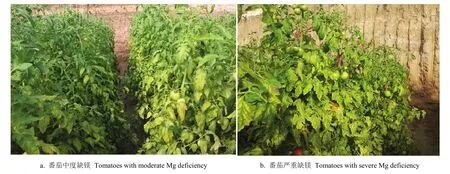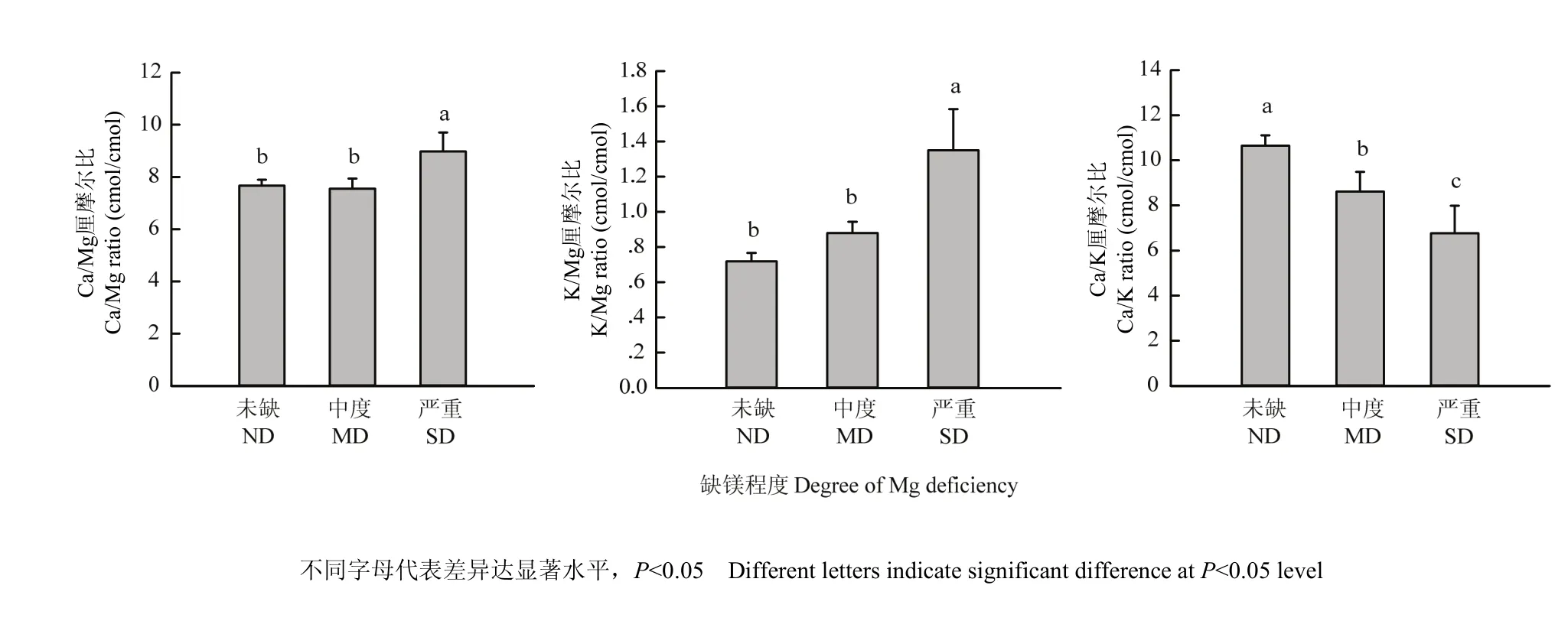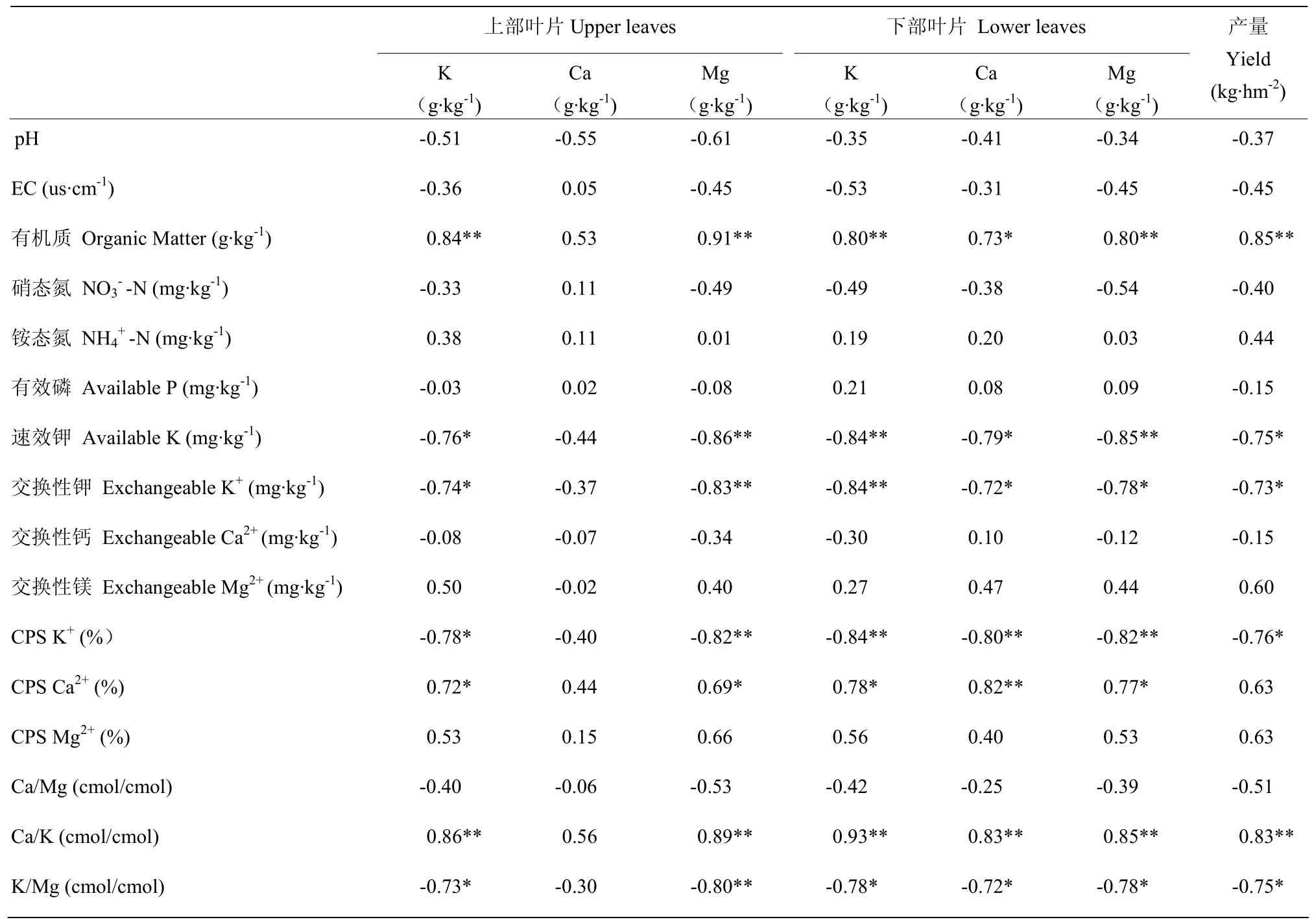日光温室栽培番茄镁缺乏与土壤阳离子平衡的关系
2016-10-18王辉民陈竹君曹京阳刘淑敏周建斌
闫 波,周 婷,王辉民,陈竹君,曹京阳,刘淑敏,周建斌
(1西北农林科技大学资源环境学院/农业部西北植物营养与农业环境重点实验室,陕西杨凌 712100;2杨陵区农业技术推广服务中心,陕西杨凌 712100)
日光温室栽培番茄镁缺乏与土壤阳离子平衡的关系
闫波1,周婷1,王辉民1,陈竹君1,曹京阳2,刘淑敏2,周建斌1
(1西北农林科技大学资源环境学院/农业部西北植物营养与农业环境重点实验室,陕西杨凌 712100;2杨陵区农业技术推广服务中心,陕西杨凌 712100)
【目的】北方石灰性土壤钙、镁含量丰富,镁素供应充足,缺镁主要发生在南方高度风化的酸性土壤,但近年来北方日光温室栽培番茄等作物缺镁现象频发。因此,解析导致石灰性土壤日光温室栽培番茄缺镁的主要因素,可为日光温室番茄镁素缺乏的矫正和合理施肥提供科学依据。【方法】在陕西省杨凌示范区大寨镇日光温室栽培基地,于秋冬茬栽培番茄普遍发生缺镁的盛果期(11月份),选择番茄定植时间和品种一致,叶片形态呈现不同程度缺镁症(不缺镁:外观未观察到番茄缺镁失绿症状;中度缺镁:上部1/2叶片未表现缺镁失绿症状;严重缺镁:上、下叶片均表现缺镁失绿症状)的日光温室,分别采集温室0—20 cm耕层土样和番茄第2穗与第3穗果间的叶片(下部叶片)以及上部完全展开的新生叶片(上部叶片)样品;测定土壤pH、电导率、有机质、NO3--N、NH4
+-N、有效磷、速效钾以及交换性钾、钙、镁离子含量,番茄叶片钾、钙、镁含量,计算土壤交换性钾、钙、镁离子饱和度和K/Mg、Ca/Mg、Ca/K离子比例,并调查番茄产量;分析番茄缺镁程度不同的日光温室土壤基本性质差异,交换性钾、钙、镁离子含量及平衡状况与番茄叶片养分含量和产量的关系。【结果】番茄缺镁程度不同的温室土壤性质存在差异,番茄缺镁严重的土壤电导率、NO3--N、速效钾显著增加。番茄缺镁和不缺镁的土壤交换性镁含量均高于缺镁临界值(0.5 cmol·kg-1);随番茄缺镁程度加剧,钾离子饱和度增加,钙、镁离子饱和度降低,Ca/Mg和K/Mg离子比例升高,Ca/K离子比例下降;与不缺镁相比,番茄中度缺镁的土壤交换性钾离子饱和度、K/Mg离子比例均增加了22%,严重缺镁的则分别显著增加了56%和88%;番茄严重缺镁的土壤Ca/Mg比例较未缺镁的升高了17%;番茄中度缺镁和严重缺镁的土壤Ca/K比未缺镁的分别降低了19%和37%。番茄中度缺镁的土壤Ca/Mg略高于适宜值上限(7.0),K/Mg则高于适宜上限(0.6)47%,番茄严重缺镁的土壤Ca/Mg和K/Mg分别高于适宜值上限28%和125%。番茄上、下部叶片镁含量和番茄产量分别与土壤速效钾含量、交换性钾含量、钾离子饱和度、K/Mg均呈极显著或显著负相关,与土壤有机质和Ca/K呈极显著或显著正相关,而与土壤交换性镁含量、镁离子饱和度及Ca/Mg比例间未达显著相关性;随番茄缺镁程度加剧,产量显著降低,中度和严重缺镁的番茄产量分别降低了38%和60%。【结论】番茄缺镁程度不同的温室土壤交换性镁含量均在丰富水平,而镁离子饱和度偏低;番茄表现缺镁的土壤Ca/Mg和K/Mg均呈养分比例失调状态,特别是K/Mg严重失调。土壤中钾离子过高造成阳离子比例失调是诱导番茄缺镁症的主要因素,温室高集约栽培下过量施肥影响阳离子养分平衡是值得关注的问题。
日光温室;番茄缺镁;土壤性质;阳离子平衡;养分含量
0 引言
【研究意义】目前,中国已成为世界上设施栽培面积最大的国家[1],占世界设施园艺面积的80%,面积超过606.7万hm2。其中日光温室蔬菜栽培成为北方地区反季节蔬菜生产的主要方式,也是许多地区农民增收和农业增效的有效方式和支柱产业之一。但日光温室栽培生产中过量不平衡施肥问题突出,养分过量累积带来诸多问题[2-4],近年来北方日光温室栽培番茄等作物缺镁现象频发就是其中突出问题之一[5-8]。据笔者在陕西杨凌农业高新技术产业示范区2009年建设的万亩设施栽培基地的调查显示,从2012年开始,70%以上日光温室番茄出现典型缺镁症状[9],中等和严重缺镁番茄分别减产40%和60%。山东的调查数据表明[6],中等缺镁大棚番茄减产30%—40%,严重的减产80%—90%,制约了温室栽培的可持续健康发展。因此,有必要探明日光温室高度集约种植制度下影响石灰性土壤镁生物有效性的原因。【前人研究进展】虽然对植物镁素营养研究已有近200年的历史,但与其他大、中量营养元素的研究相比,对镁营养机理的研究相对较少[10]。因此,有学者认为,至少近10年来镁的重要性被科学家低估,称镁为“被遗忘的元素”[11-13]。作物缺镁症的发生一般由两方面的原因引起,土壤镁绝对量的缺乏(直接缺乏)和养分失调产生的阳离子拮抗作用引起的间接缺乏[14-16]。绝对量的缺乏因成土矿物镁含量低、成土过程镁迁移淋溶损失或长期不平衡施肥导致作物对土壤镁的吸收耗竭而产生,一般高度风化的酸性土壤镁含量较少,CEC小,易发生作物缺镁。北方石灰性土壤钙、镁含量高[17-18],镁素供应丰富,一般来说不会导致镁的直接缺乏。对植物镁吸收产生竞争作用的主要是钾和钙离子的影响,其中以钾对镁离子的拮抗作用最为突出[19],也有报道锰和铝过量导致镁的吸收降低。而关于北方石灰性土壤作物镁缺乏原因及施用镁肥的研究较少[8,18]。陈竹君等[8]从土壤化学角度研究了石灰性土壤日光温室栽培番茄不同程度缺镁的土壤水溶盐分中离子组成、比例及镁、钙、钾离子活度等的变化及关系,认为盐分累积使镁离子活度大幅降低,以及钾富集对植物吸收镁的拮抗作用是石灰性土壤上番茄缺镁的主要诱因。【本研究切入点】日光温室栽培氮磷钾肥过量施用引起的土壤盐分累积、土壤退化及环境问题已引起普遍关注,但对交换性钙、镁离子变化特征及钾与钙、镁阳离子平衡状况研究尚不多见,特别是土壤交换性钾、钙、镁阳离子平衡与温室番茄镁缺乏分析研究鲜见报道。【拟解决的关键问题】本研究通过分析番茄缺镁程度不同的日光温室土壤基本性质差异,交换性钾、钙、镁平衡状况与番茄养分吸收和产量间的关系,解析导致石灰性土壤日光温室番茄缺镁的主要因素,为日光温室番茄缺镁症矫正和科学施肥提供依据。
1 材料与方法
1.1供试材料
研究区位于陕西省杨凌示范区大寨镇日光温室栽培基地,日光温室建于2009年,主要种植制度为一年两季(秋冬茬-春茬),秋冬茬番茄定植时间一般为8月份,拉秧期为次年1月份,随后定植下茬作物。种植模式包括番茄-番茄或番茄-黄瓜、番茄-小型西瓜等,土壤类型均为土(系统分类为土垫旱耕人为土)。
于2014年11月15日(11月份为当地秋冬茬番茄(‘铁观音’)盛果期,此时,从果实叶片开始陆续向上蔓延出现典型缺镁失绿症)。选择定植时间(2014年8月5日)一致,根据番茄叶片是否出现典型缺镁症状及严重程度(图1),划分为不缺镁、中度缺镁和严重缺镁(不缺镁:外观未观察到番茄缺镁症状;中度缺镁:上部1/2叶片未表现缺镁失绿症状;严重缺镁:上下叶片均表现缺镁失绿症状)的温室各3个,采集各温室0—20 cm耕层多点混合土样;同时采集每个温室第2穗和第3穗果间的番茄叶片(下部叶片)以及上部完全展开的新生叶片(上部叶片),清洗后杀青,60℃烘干。此外,调查采样温室当季施肥、灌溉量(表1)以及番茄总产量。当地有机肥主要施用干鸡粪和干羊粪,种植期间地面全覆盖聚乙烯薄膜,灌溉和追肥采用滴灌+文丘里施肥器的水肥一体化系统。

图1 缺镁程度不同的番茄叶片Fig. 1 Tomatoes with different degrees of Mg deficiency

表1 番茄不同缺镁程度的日光温室当季施肥灌水量Table 1 Fertilization and irrigation rates with different degrees of Mg deficiency of tomato in solar greenhouse
1.2分析测定
分析土壤样品pH、电导率、有机质、硝态氮、铵态氮、有效磷、速效钾以及交换性钾、钙、镁含量。其中pH用雷磁PHS-3C型pH计测定;电导率用雷磁DDS-307A型电导率仪测定(5∶1水土比);有机质为重铬酸钾-外加热法测定。硝态氮和铵态氮用鲜土壤样以1 mol·L-1氯化钾溶液浸提,流动分析仪测定;有效磷用钼锑抗比色-分光光度法测定;速效钾用1 mol·L-1醋酸铵浸提,火焰光度法测定。土壤交换性钾、钙、镁采用1 mol·L-1pH 8.2的醋酸钠反复交换至胶体上无钙离子[20],交换溶液分别用火焰光度法测定钾,原子吸收分光光度法测定钙、镁。由于石灰性土壤交换性阳离子主要为K+、Ca2+、Mg2+,分别以K+/(Ca2++Mg2++K+)、Ca2+/(Ca2++Mg2++K+)和Mg2+/(Ca2++Mg2++K+)百分率代表交换性钾、钙、镁离子饱和度(cation percent saturation,分别用CPSCa2+、CPSMg2+和CPSK+表示)。
番茄叶片全钾、钙、镁含量采用干灰化法灰化,火焰光度法测钾,原子吸收分光光度法测定钙、镁[20]。
1.3数据分析
试验数据采用Microsoft Excel和SAS软件进行统计分析,Sigma Plot 12.0作图。
2 结果
2.1番茄缺镁程度不同的土壤理化性质
番茄缺镁程度不同的土壤pH、NH4+-N和有效磷含量无显著差异(表2),番茄严重缺镁的土壤电导率、NO3--N含量显著高于番茄中度缺镁和不缺镁的土壤,番茄严重缺镁的土壤速效钾含量也显著高于番茄未缺镁的土壤。番茄严重缺镁的土壤NO3--N含量高于蔬菜生长土壤适宜上限值(150 mg·kg-1)[21],番茄缺镁土壤速效钾含量则均大于设施菜地的过量值(350 mg·kg-1)[22]。
2.2番茄缺镁程度不同的土壤交换性阳离子组成及
比例
随着番茄缺镁程度加剧,土壤交换性K+含量呈增加趋势,番茄严重缺镁的土壤交换性K+含量显著高于番茄不缺和中度缺镁的土壤,而番茄严重缺镁的土壤交换性Mg2+含量显著低于番茄不缺和中度缺镁的土壤(表3);番茄不同缺镁程度间土壤交换性Ca2+含量和交换性K++Ca2++Mg2+总量无显著差异。

表2 番茄缺镁程度不同的土壤基本理化性质Table 2 Physical and chemical properties of soils where tomatoes displayed different degrees of magnesium deficiency
土壤交换性离子饱和度是评价土壤养分离子供应状况的另一重要指标,表3可知,番茄缺镁程度不同的土壤交换性离子饱和度变化与含量变化规律一致,K+饱和度增加,Ca2+、Mg2+饱和度下降。与番茄不缺镁相比,番茄中度缺镁的土壤交换性K+饱和度增加了22%,Ca2+、Mg2+饱和度没有明显降低;番茄严重缺镁的土壤K+饱和度增加了56%,Ca2+饱和度下降了3.0%,Mg2+饱和度下降了17%。

表3 番茄缺镁程度不同的土壤交换性阳离子组成Table 3 Compositions of exchangeable cations in soils where tomatoes displayed different degrees of magnesium deficiency
随番茄缺镁程度加剧,土壤交换性离子Ca/Mg和K/Mg比例升高(图1),番茄严重缺镁的土壤Ca/Mg比未缺的土壤显著升高了17%;番茄中度缺镁的土壤比未缺镁的K/Mg升高22%,严重缺镁的则显著升高88%;Ca/K则随番茄缺镁程度加剧显著降低,番茄中度缺镁和严重缺镁的的土壤Ca/K比未缺镁的分别降低了约19%和37%。
2.3缺镁程度不同番茄叶片养分含量及产量

图2 番茄缺镁程度不同的土壤阳离子比例Fig. 2 Ratios of Ca/Mg, K/Mg and Ca/ K in soils where tomatoes displayed different degrees of Mg-deficiency

表4 番茄缺镁程度不同的叶片养分含量及番茄产量Table 4 Leave nutrient contents and fruit yields of tomatoes displayed different degrees of magnesium deficiency
随着缺镁程度加剧番茄上部叶片和下部叶片中钾、钙、镁含量均呈下降趋势(表4),且番茄中度和严重缺镁的上、下部叶片钾、钙、镁含量均显著低于番茄未表现缺镁症的叶片。随缺镁程度加剧番茄产量显著降低,与未表现缺镁症相比,中度和严重缺镁番茄产量分别降低了约38%和60%。
2.4番茄叶片养分含量和产量与土壤性质的关系
番茄叶片镁含量和产量与土壤性质相关性分析表明,上、下部叶片镁含量及番茄产量与土壤速效钾、交换性钾、钾离子饱和度、K/Mg均呈极显著或显著负相关(表5),与有机质和Ca/K呈极显著或显著正相关,而与交换性镁、镁离子饱和度及Ca/Mg间未达到显著相关性;此外,上、下部叶片钾含量及下部叶片钙含量与土壤速效钾、交换性钾、钾离子饱和度、K/Mg亦均呈极显著或显著负相关。

表5 番茄叶片养分含量和产量与土壤理化性质的相关性Table 5 Correlation between leaf nutrient contents, fruit yield of tomato and soil physical-chemical properties
3 讨论
3.1番茄缺镁程度不同的土壤有效镁含量及阳离子平衡
一般采用有效镁含量、离子饱和度以及镁与其他阳离子间的平衡关系等3个指标来评价土壤镁的有效性[23]。以土壤交换性镁丰缺指标看,番茄缺镁和不缺镁的土壤交换性镁含量均高于以往认为的缺镁临界值(0.5 cmol·kg-1)4倍以上[24],说明石灰性土壤温室栽培番茄缺镁不是土壤有效镁含量缺乏所造成的。土壤养分离子饱和度反映了养分的供应强度,KOPITTKE等[23]提出,理想的土壤交换性钙、镁、钾离子饱和度为65%、10%和5%,WHITE[25]认为,土壤胶体上阳离子饱和度适宜的比例关系应为80%的Ca2+、15%的Mg2+及K+、Na+和NH4+等其他阳离子占5%。显然这两个指标适宜不同的土壤,前者适宜盐基不饱和的酸性土壤,后者适宜于盐基饱和的中性和石灰性土壤。也有研究认为,土壤交换性镁的饱和度低于10%[24]就有缺乏的可能。因此,从番茄缺镁程度不同的土壤交换性镁离子饱和度判断,镁素供应强度并不高,番茄严重缺镁的土壤镁离子饱和度处于缺乏状态。
阳离子比例失调产生的拮抗作用[25-27]是影响养分离子生物有效性的重要因素。研究表明,土壤钾、钙离子过多会抑制植物对镁的吸收,特别是钾对镁、钙二价离子吸收具有较强竞争作用。TISDALE等[27]提出,温室作物适宜的土壤交换性K/Mg比应小于0.6;也有学者研究表明,当K/Mg比例大于0.4,钾会明显抑制镁的吸收,当Ca/Mg比例大于7.0时,钙会抑制作物镁的吸收[28]。中国目前尚未提出针对不同土壤、作物及栽培环境适宜的钙、镁、钾比例。番茄未表现缺镁的土壤Ca/Mg和K/Mg分别为7.7和0.7,均略高于临界值7.0和0.6,说明番茄外观形态虽未表现出缺镁症,但可能存在潜在相对缺乏;番茄中度缺镁的土壤Ca/Mg略高于适宜值上限,K/Mg则比适宜值上限(0.6)高47%;番茄严重缺镁的土壤Ca/Mg和K/Mg与适宜值上限7.0和0.6相比分别高出的28%和125%。从钾、钙、镁离子间比例变化看,土壤胶体上吸附的K+过高,是导致阳离子比例失调的主要因素,这一结果也与温室栽培过量的钾肥投入,造成土壤钾素大量盈余相一致[29-30]。
3.2日光温室番茄缺镁因素分析
本研究相关性分析显示,番茄叶片镁含量及产量与反映土壤钾素供应状况的指标(土壤速效钾、交换性钾、钾离子饱和度、K/Mg和K/Ca)均呈极显著或显著负相关(表5),而与土壤交换性镁含量并无相关性,钾、钙、镁离子平衡关系亦表明,番茄表现缺镁的土壤K/Mg失调。综合上述结果,说明土壤中有效钾过高造成离子比例失调是影响番茄叶片镁含量和产量降低的主要因素。
目前,温室高集约栽培中过量氮、磷肥施用带来的养分盈余和环境问题引起人们的关注,钾肥过量施用虽然对环境无明显影响,但钾肥过量施用造成的阳离子平衡失调,进而影响作物对其他养分吸收及产量的降低并未引起足够重视。特别是钾、钙、镁丰富且易于在土壤中累积的北方石灰性土壤地区,温室栽培番茄等作物钾肥的过量施用在一些地区尚有严重化趋势,许多冲施肥为高钾含量型肥料,2015年笔者对杨凌58座温室土壤速效钾含量测定结果显示,平均含量高达735 mg·kg-1,最高达1 423 mg·kg-1,含量超过土壤供钾过量临界值(350 mg·kg-1)的占94%。因此,钾肥过量引起的土壤胶体上阳离子组成改变和平衡失调,进而影响其他养分离子吸收、转运等所造成的作物生理紊乱值得关注和重视。
4 结论
(1)番茄缺镁严重的土壤电导率、NO3--N、速效钾、交换性钾、钾离子饱和度、Ca/Mg和K/Mg比例均显著增加,土壤有机质含量,交换性Mg、Mg离子饱和度和Ca/K显著低于番茄未表现缺镁的土壤。
(2)根据已有土壤镁素丰缺指标判断,番茄缺镁程度不同的温室土壤镁含量均在丰富水平,而镁离子饱和度偏低。番茄表现缺镁的土壤Ca/Mg和K/Mg均呈阳离子比例失调状态,特别是K/Mg严重失调。
(3)随番茄缺镁程度加剧,产量显著降低,中度和严重缺镁的番茄产量分别降低约38%和60%。土壤中钾离子过高造成离子比例失调是诱导番茄生理紊乱出现缺镁症和产量降低的主要因素。
References
[1] 喻景权. "十一五"我国设施蔬菜生产和科技进展及其展望. 中国蔬菜, 2011, 2: 11-23.
YU J Q. Progress in protected vegetable production and research during ‘The Eleventh Five-year Plan' in China. China Vegetables,2011, 2: 11-23. (in Chinese)
[2] 李天来, 杨丽娟. 作物连作障碍的克服——难解的问题. 中国农业科学, 2016, 49(5): 916-918.
LI T L, YANG L J. Overcoming continuous cropping obstacles-the difficult problem. Scientia Agricultura Sinica, 2016, 49(5): 916-918.(in Chinese)
[3] 李若楠, 武雪萍, 张彦才, 王丽英, 李孝兰, 陈丽莉, 翟凤芝. 滴灌氮肥用量对设施菜地硝态氮含量及环境质量的影响. 植物营养与肥料学报, 2015, 21(6): 1642-1651.
LI R N, WU X P, ZHANG Y C, WANG L Y, LI X L, CHEN L L, ZHAI F Z. Nitrate nitrogen contents and quality of greenhouse soil applied with different N rates under drip irrigation. Journal of Plant Nutrition and Fertilizer, 2015, 21(6): 1642-1651. (in Chinese)
[4] 王丽英, 武雪萍, 张彦才, 李若楠, 陈丽莉, 陈 清. 适宜施氮量保证滴灌日光温室黄瓜番茄产量降低土壤盐分及氮残留. 农业工程学报, 2015, 31(17): 91-98.
WANG L Y, WU X P, ZHANG Y C, LI R L, CHEN L L, CHEN Q. Optimal nitrogen application rate to ensure cucumber and tomatoyield with drip irrigation in greenhouse and to reduce soil salinity and nitrate residue. Transactions of the Chinese Society of Agricultural Engineering, 2015, 31(17): 91-98. (in Chinese)
[5] 杨军芳, 周晓芬, 冯伟. 土壤与植物镁素研究进展概述. 河北农业科学, 2008, 12(3): 91-93.
YANG J F, ZHOU X F, FENG W. Summary of research advance between soil and magnesium nutrition in plants. Journal of Hebei Agricultural Sciences, 2008, 12(3): 91-93. (in Chinese)
[6] 张西森. 温棚番茄缺镁危害与防治. 现代农业科技, 2007, 12: 75-76.
ZHANG X S. Magnesium deficiency harm and prevention of greenhouse tomato. Modern Agricultural Science and Technology,2007, 12: 75-76. (in Chinese)
[7] 赵春年. 设施蔬菜缺镁症状与施肥技术. 河北农业科技, 2008(2): 49-50.
ZHAO C N. Symptom of magnesium deficiency and fertilization technology in facility vegetable. Hebei Agricultural Science and Technology, 2008(2): 49-50. (in Chinese)
[8] 陈竹君, 赵文艳, 张晓敏, 周从从, 周建斌. 日光温室番茄缺镁与土壤盐分组成及离子活度的关系. 土壤学报, 2013, 50(2): 388-395.
CHEN Z J, ZHAO W Y, ZHANG X M, ZHOU C C, ZHOU J B. Relationship of magnesium deficiency of tomato with salt composition and ion activities in greenhouse soil. Acta Pedologica Sinica, 2013, 50(2): 388-395. (in Chinese)
[9] 马国瑞,石伟勇. 蔬菜营养失调症原色图谱. 北京: 中国农业出版社, 2002: 49-64.
MA G R, SHI W Y. Colour Pictures of Nutritional Disorders of Vegetable Crops. Beijing: China Agriculture Press, 2002: 49-64. (in Chinese)
[10] CAKMAK I. Magnesium in crop production, food quality and human health. Plant and Soil, 2013, 368: 1-4.
[11] CAKMAK I, YAZICI A M. Magnesium: a forgotten element in crop production. Better Crops, 2010, 94: 23-25.
[12] GRANSEE A, FüHRS H. Magnesium mobility in soils as a challenge for soil and plant analysis, magnesium fertilization and root uptake under adverse growth conditions. Plant and Soil, 2013, 368: 5-21.
[13] NATHALIE V, CHRISTIAN H. Physiological and molecular responses to magnesium nutritional imbalance in plants. Plant and Soil, 2013, 368: 87-99.
[14] DIEM B, GODBOLD D L. Potassium, calcium and magnesium antagonism in clones of popolus trichocarpa. Plant and Soil, 1993,155(156): 411-414.
[15] 鲁如坤. 土壤-植物营养学原理和施肥. 北京: 化学工业出版社,1998: 287-295. LU R K. Principles of Soil Plant Nutrition and Fertilization. Beijing: Chemical Industry Press, 1998: 287-295. (in Chinese)
[16] MENGELK, KIRKBY E A. Principles of Plant Nutrition. 5th ed. Dordrecht, The Netherlands: Kluwer Academic Publishers, 2001: 541-552.
[17] 白由路, 金继运, 杨俐苹. 我国土壤有效镁含量及分布状况与含镁肥料的应用前景研究. 土壤肥料, 2004(2): 3-5.
BAI Y L, JIN J Y, YANG L P. Study on the content and distribution of soil available magnesium and foreground of magnesium fertilizer in China. Soil and Fertilizer Sciences in China, 2004(2): 3-5. (in Chinese)
[18] 丁玉川, 焦晓燕, 聂督, 程滨, 赵瑞芬, 刘平. 山西农田土壤交换性镁含量、分布特征及其与土壤化学性质的关系. 自然资源学报,2012, 27(2): 311-321.
DING Y C, JIAO X Y, NIE D, CHENG B, ZHAO R F, LIU P. Contents and distribution of exchangeable magnesium and their relationship with the chemical properties of main farm soils in Shanxi province, China. Journal of Natural Resources, 2012, 27(2): 311-321.(in Chinese)
[19] FARHAT N, RABHI M, FALLEH H LENGLIZ K, SMAOUI A,ABDELLY C, LACHAÂL M, KARRAY-BOURAOUI N. Interactive effects of excessive potassium and Mg deficiency on safflower. Acta Physiologiae Plantarum, 2013, 35: 2737-2745.
[20] 鲍士旦. 土壤农化分析. 第3版. 北京: 中国农业出版社, 2000: 191-193.
BAO S D. Soil Agriculture Chemical Analysis. 3rd ed.Beijing: China Agriculture Press, 2000: 191-193. (in Chinese)
[21] 汤丽玲, 陈清, 李晓林, 陈永智,丁光国. 日光温室秋冬茬番茄氮素供应目标值的研究. 植物营养与肥料学报, 2005, 11(2): 230-235.
TANG L L, CHEN Q, LI X L, CHEN Y Z, DING G G. Studies on the target value of nitrogen supply for greenhouse tomato growth during autumn-winter season. Journal of Plant Nutrition and Fertilizer, 2005,11(2): 230-235. (in Chinese)
[22] MILLER R W, DONAHUE R L. Soils in Our Environment. New Jersey: Prentice-Hall Inc, 1995: 357-359.
[23] KOPITTKE P M, MENZIES N W. A review of the use of the basic cation saturation ratio and the ‘ideal' soil. Soil Science Society of America Journal, 2007, 71: 259-265.
[24] 袁可能. 植物营养元素的土壤化学. 北京: 科学出版社, 1983: 85-124.
YUAN K N. Soil Chemistry of Plant Nutrient Elements. Beijing: Science Press, 1983: 85-124. (in Chinese)
[25] WHITE R E. Principle and Practice of Soil Science. 4rd ed. Victoria,Australia: Blackwell Publishing, 2006: 140-141.
[26] MARSCHNER H. Mineral Nutrition of Higher Plants. 3rd ed. New York: Academic Press, 2012: 315-330.
[27] TISDALE S L, NELSON W L, BEATON J D. Soil Fertility and Fertilizers. 5rd ed. New York: Macmillan Publishing Co., 1993: 432-436.
[28] MORTON A R, TROLOVE S N, KERCKHOFFS L H J. Magnesium deficiency in citrus grown in the Gisborne district of New Zealand. New Zealand Journal of Crop and Horticultural Science, 2008, 36(3): 199-213.
[29] 白新禄, 高佳佳, 陈竹君, 雷金繁, 周建斌. 新建日光温室土壤养分平衡与累积特性. 中国土壤与肥料, 2014(2): 1-5.
BAI X L, GAO J J, CHEN Z J, LEI J F, ZHOU J B. Nutrient accumulation and balances in soils of the new-established greenhouses. Soil and Fertilizer Sciences in China, 2014(2): 1-5. (in Chinese)
[30] GAO J J, BAI X L, ZHOU B, ZHOU J B, CHEN Z J. Soil nutrient content and nutrient balances in newly-built solar greenhouses in northern China. Nutrient Cycling in Agroecosystems, 2012, 94: 63-72.
(责任编辑赵伶俐)
The Relationships Between Magnesium Deficiency of Tomato and Cation Balances in Solar Greenhouse Soil
YAN Bo1, ZHOU Ting1, WANG Hui-min1, CHEN Zhu-jun1, CAO Jing-yang2, LIU Shu-min2, ZHOU Jian-bin1
(1College of Natural Resources and Environment, Northwest A&F University/Key Laboratory of Plant Nutrition and the Agri-Environment in Northwest China, Ministry of Agriculture, Yangling 712100, Shaanxi;2Yangling Agricultural Technology Extension Station, Yangling 712100, Shaanxi)
【Objective】It is generally considered that the contents of calcium and magnesium (Mg) in calcareous soil are rich. Therefore, Mg deficiency usually occurs in acidic soil in south China, where the weathering is very strong. However, Mg deficiency of tomato under solar greenhouses in calcareous soil in north China becomes common. It is urgent to understand the reason of Mg deficiency of tomato under solar greenhouses in the region, which will provide scientific knowledge to solve the Mg deficient problem in the solar greenhouse. 【Method】The different degrees of Mg deficiency of tomatoes with the same transplanting times and varieties in the greenhouses in Dazhai, Yangling, Shaanxi were chosen. The degrees of tomato Mg deficiency were divided into three types based on the severity of the symptoms. The three types of Mg deficiency included the leaves without Mg deficiency, the leaves with moderate (half of the upper leaves showed deficiency) and severe (all leaves showed deficiency) Mg deficiency. The soil samples (0-20 cm), lower leaves samples (the leaves between the second and third fruit sets) and upper leaves samples (the fully developed leaves on the top plant) were taken from different greenhouses. The basic soil properties were determined, including soil pH, electric conductivity (EC), organic matter, available nitrogen, phosphorus, and potassium, and soil exchangeable K+, Ca2+, and Mg2+, and their contents in tomato leaves. The ratios of exchangeable K+, Ca2+, and Mg2+ions, and their saturation percentages in soil colloid were calculated. The fruit yields of different greenhouses were also surveyed. The relationships between Mg deficiency of tomato and the parameters determined were analyzed.【Result】There were significant differences in soil properties between the greenhouses with different degrees of Mg deficiency. The soil EC, contents of nitrate, readily available K in soil of tomato with severe Mg deficiency were significantly increased. The content of exchangeable Mg ions in soils was higher than the critical value of Mg deficiency both in tomatoes with and without Mg deficient symptoms. With the severity of Mg deficiency of tomato, the saturation percentage of K ion was increased and the ratios of Ca/Mg, and K/Mg also increased. On the contrary, the saturation percentages of Ca2+and Mg2+ions, and the ratio of Ca/K were decreased. Compared with tomatoes without Mg deficiency, the saturation percentage of K+and the ratio of K/Mg in soil with moderate Mg deficiency were increased both by 22%, and soil with severe Mg deficiency increased by 56% and 88%, respectively. Compared to soil without tomato Mg deficiency, the ratios of Ca/Mg in soil with severe Mg deficiency was increased by 17%, and the ratios of Ca/K in soil with moderate and severe Mg deficiency were decreased by 19% and 37%, respectively. The soil Ca/Mg ratio of tomato with moderate Mg deficiency was slightly higher than optimum value of Ca/Mg ratio (7.0), and K/Mg ratios was higher than optimum value (0.6) by 47%. The ratios of soil Ca/Mg, and K/Mg were higher than optimum value by 28% and 125%, respectively. The Mg contents in both upper and lower leaves and fruit yield of tomato were significantly and negatively correlated with the readily available K, exchangeable K+, saturation percentages of K+, and K/Mg ratio, and positively correlated with soil organic matter content and Ca/K ratio; and their correlations with exchangeable Mg2+and its saturation percentages, and the ratio of Ca/Mg were not significant. With the severity of Mg deficiency,the tomato fruit yields were decreased rapidly. The decreasing rates of fruit yields in moderate and severe Mg deficiency were 38% and 60%.【Conclusion】 The contents of soil exchangeable Mg2+was at optimum levels for tomatoes with or without Mg deficiency;however, the Mg2+saturation percentages was lower. The ratios of Ca/Mg, and K/Mg in soil with different Mg deficiency were imbalance, especially for the K/Mg ratio. The high level of K resulted in imbalances of cation ions was the main reason of Mg deficiency in solar greenhouse of calcareous soil. Therefore, more attentions are needed to deal with this problem.
solar greenhouse; magnesium deficiency of tomato; soil properties; balances of cations; nutrient contents
2016-04-19;接受日期:2016-08-12
国家“十二五”科技支撑计划(2012BAD15B04)、陕西省农业攻关项目(2014K01-14-03)、中英农业生产中养分资源可持续利用合作项目
联系方式:闫波,E-mail:sdyanbo@163.com。通信作者陈竹君,E-mail:zjchen@nwsuaf.edu.cn
